Critical Analysis: Market Failure & Bias in the 2008 Crisis
VerifiedAdded on 2023/06/15
|14
|3445
|125
Essay
AI Summary
This essay critically assesses the extent to which market failure and behavioral biases explain the 2008 financial crisis in the United States. It begins by providing a background of the crisis, highlighting the role of mortgage-backed securities and collateralized debt obligations. The analysis then focuses on market failures such as monopolies in credit rating agencies and asymmetric information regarding the quality of sub-prime mortgages. It further explores behavioral biases, including confirmation bias and overconfidence, that contributed to the crisis. The essay also touches upon the efficient market hypothesis and moral hazard, concluding that a combination of market imperfections and behavioral factors played a significant role in the crisis.
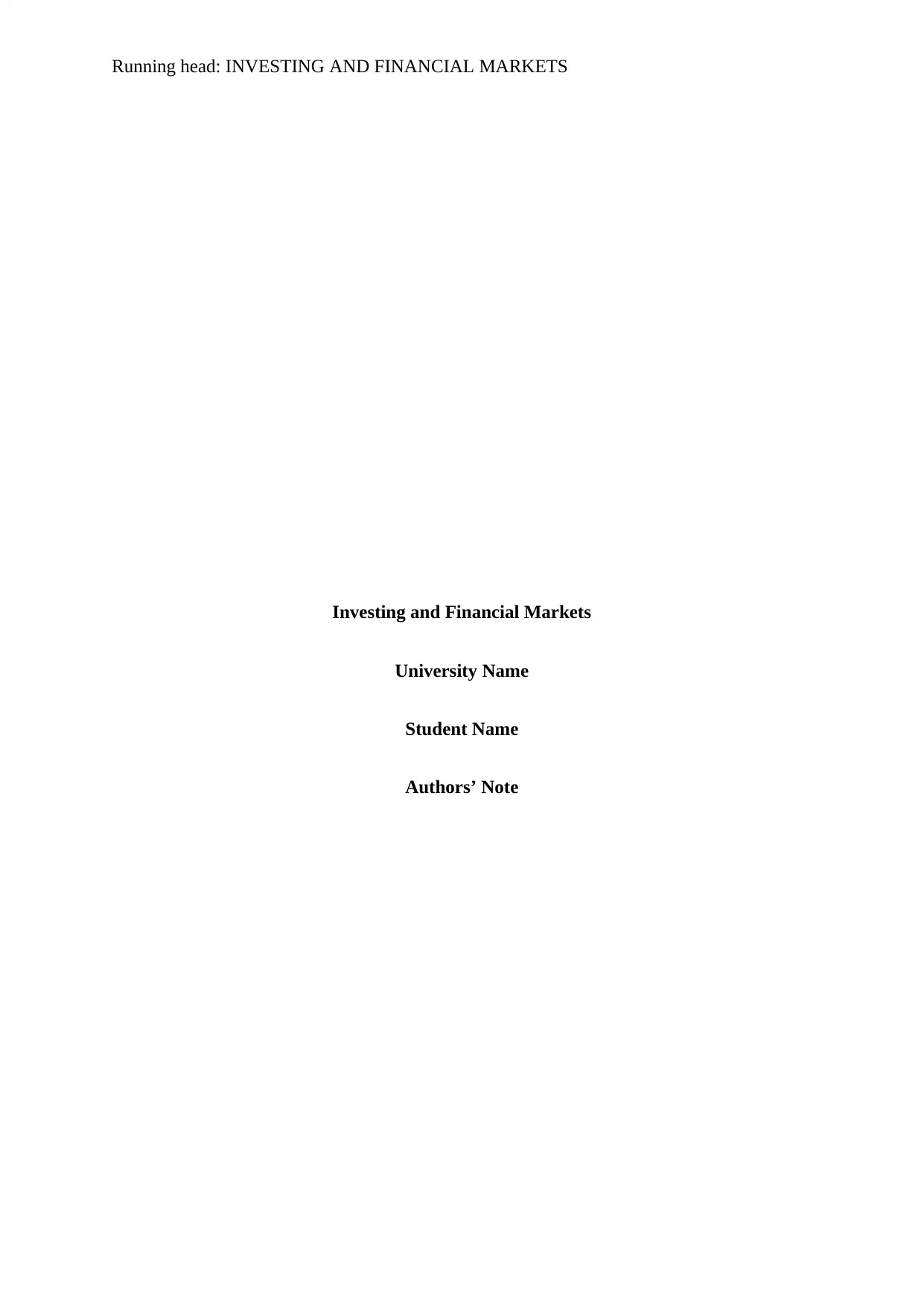
Running head: INVESTING AND FINANCIAL MARKETS
Investing and Financial Markets
University Name
Student Name
Authors’ Note
Investing and Financial Markets
University Name
Student Name
Authors’ Note
Paraphrase This Document
Need a fresh take? Get an instant paraphrase of this document with our AI Paraphraser
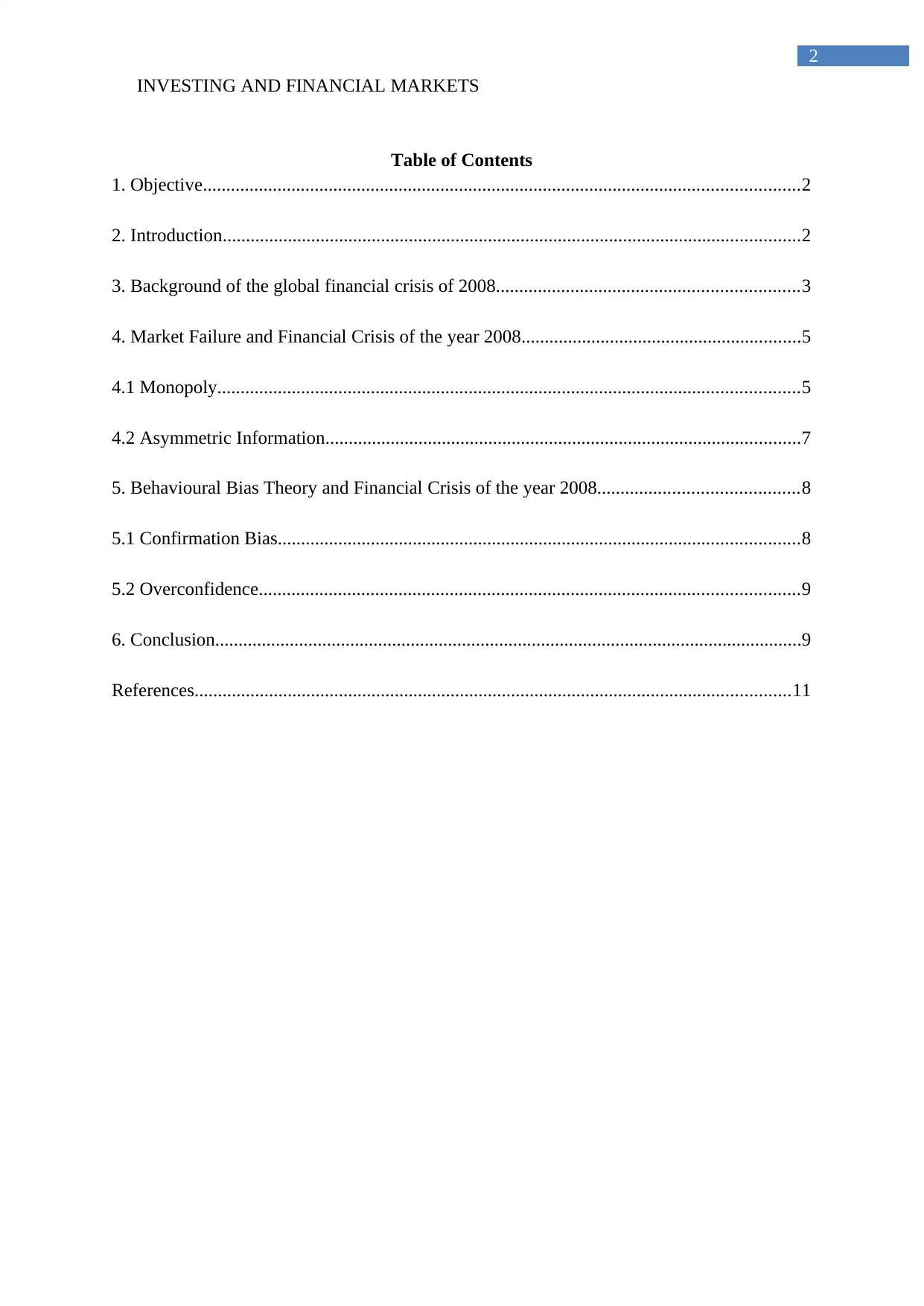
2
INVESTING AND FINANCIAL MARKETS
Table of Contents
1. Objective................................................................................................................................2
2. Introduction............................................................................................................................2
3. Background of the global financial crisis of 2008.................................................................3
4. Market Failure and Financial Crisis of the year 2008............................................................5
4.1 Monopoly.............................................................................................................................5
4.2 Asymmetric Information......................................................................................................7
5. Behavioural Bias Theory and Financial Crisis of the year 2008...........................................8
5.1 Confirmation Bias................................................................................................................8
5.2 Overconfidence....................................................................................................................9
6. Conclusion..............................................................................................................................9
References................................................................................................................................11
INVESTING AND FINANCIAL MARKETS
Table of Contents
1. Objective................................................................................................................................2
2. Introduction............................................................................................................................2
3. Background of the global financial crisis of 2008.................................................................3
4. Market Failure and Financial Crisis of the year 2008............................................................5
4.1 Monopoly.............................................................................................................................5
4.2 Asymmetric Information......................................................................................................7
5. Behavioural Bias Theory and Financial Crisis of the year 2008...........................................8
5.1 Confirmation Bias................................................................................................................8
5.2 Overconfidence....................................................................................................................9
6. Conclusion..............................................................................................................................9
References................................................................................................................................11
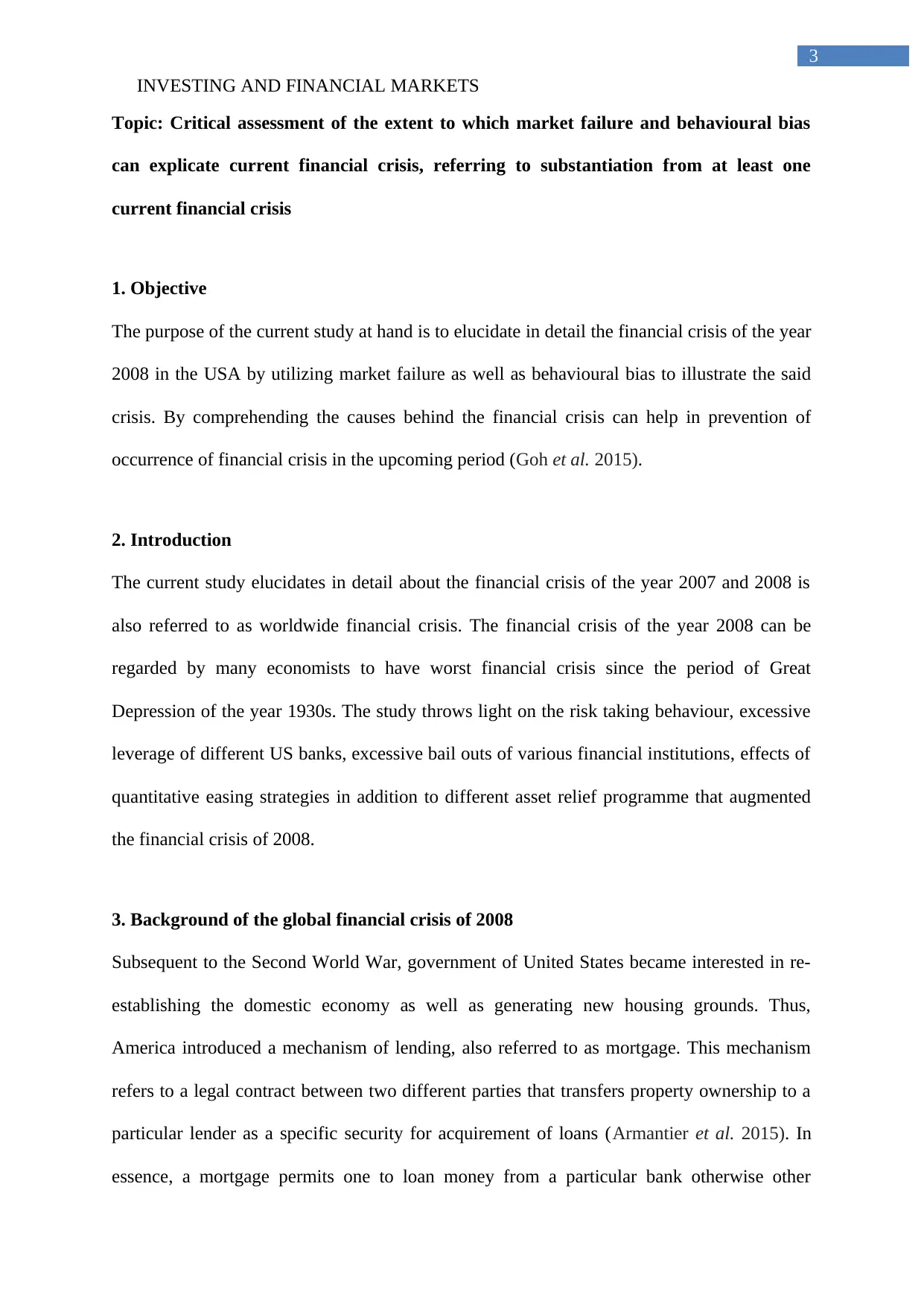
3
INVESTING AND FINANCIAL MARKETS
Topic: Critical assessment of the extent to which market failure and behavioural bias
can explicate current financial crisis, referring to substantiation from at least one
current financial crisis
1. Objective
The purpose of the current study at hand is to elucidate in detail the financial crisis of the year
2008 in the USA by utilizing market failure as well as behavioural bias to illustrate the said
crisis. By comprehending the causes behind the financial crisis can help in prevention of
occurrence of financial crisis in the upcoming period (Goh et al. 2015).
2. Introduction
The current study elucidates in detail about the financial crisis of the year 2007 and 2008 is
also referred to as worldwide financial crisis. The financial crisis of the year 2008 can be
regarded by many economists to have worst financial crisis since the period of Great
Depression of the year 1930s. The study throws light on the risk taking behaviour, excessive
leverage of different US banks, excessive bail outs of various financial institutions, effects of
quantitative easing strategies in addition to different asset relief programme that augmented
the financial crisis of 2008.
3. Background of the global financial crisis of 2008
Subsequent to the Second World War, government of United States became interested in re-
establishing the domestic economy as well as generating new housing grounds. Thus,
America introduced a mechanism of lending, also referred to as mortgage. This mechanism
refers to a legal contract between two different parties that transfers property ownership to a
particular lender as a specific security for acquirement of loans (Armantier et al. 2015). In
essence, a mortgage permits one to loan money from a particular bank otherwise other
INVESTING AND FINANCIAL MARKETS
Topic: Critical assessment of the extent to which market failure and behavioural bias
can explicate current financial crisis, referring to substantiation from at least one
current financial crisis
1. Objective
The purpose of the current study at hand is to elucidate in detail the financial crisis of the year
2008 in the USA by utilizing market failure as well as behavioural bias to illustrate the said
crisis. By comprehending the causes behind the financial crisis can help in prevention of
occurrence of financial crisis in the upcoming period (Goh et al. 2015).
2. Introduction
The current study elucidates in detail about the financial crisis of the year 2007 and 2008 is
also referred to as worldwide financial crisis. The financial crisis of the year 2008 can be
regarded by many economists to have worst financial crisis since the period of Great
Depression of the year 1930s. The study throws light on the risk taking behaviour, excessive
leverage of different US banks, excessive bail outs of various financial institutions, effects of
quantitative easing strategies in addition to different asset relief programme that augmented
the financial crisis of 2008.
3. Background of the global financial crisis of 2008
Subsequent to the Second World War, government of United States became interested in re-
establishing the domestic economy as well as generating new housing grounds. Thus,
America introduced a mechanism of lending, also referred to as mortgage. This mechanism
refers to a legal contract between two different parties that transfers property ownership to a
particular lender as a specific security for acquirement of loans (Armantier et al. 2015). In
essence, a mortgage permits one to loan money from a particular bank otherwise other
⊘ This is a preview!⊘
Do you want full access?
Subscribe today to unlock all pages.

Trusted by 1+ million students worldwide
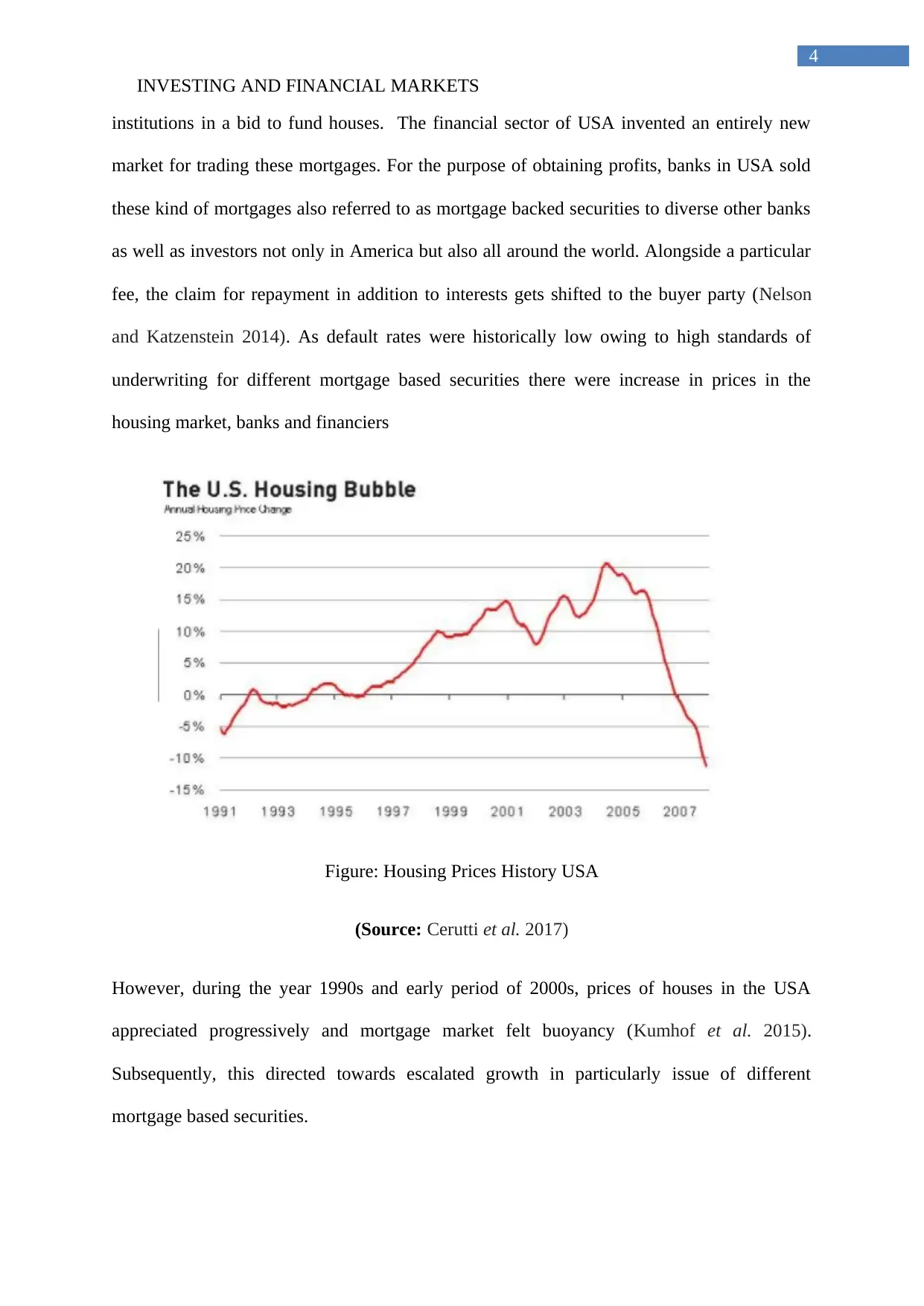
4
INVESTING AND FINANCIAL MARKETS
institutions in a bid to fund houses. The financial sector of USA invented an entirely new
market for trading these mortgages. For the purpose of obtaining profits, banks in USA sold
these kind of mortgages also referred to as mortgage backed securities to diverse other banks
as well as investors not only in America but also all around the world. Alongside a particular
fee, the claim for repayment in addition to interests gets shifted to the buyer party (Nelson
and Katzenstein 2014). As default rates were historically low owing to high standards of
underwriting for different mortgage based securities there were increase in prices in the
housing market, banks and financiers
Figure: Housing Prices History USA
(Source: Cerutti et al. 2017)
However, during the year 1990s and early period of 2000s, prices of houses in the USA
appreciated progressively and mortgage market felt buoyancy (Kumhof et al. 2015).
Subsequently, this directed towards escalated growth in particularly issue of different
mortgage based securities.
INVESTING AND FINANCIAL MARKETS
institutions in a bid to fund houses. The financial sector of USA invented an entirely new
market for trading these mortgages. For the purpose of obtaining profits, banks in USA sold
these kind of mortgages also referred to as mortgage backed securities to diverse other banks
as well as investors not only in America but also all around the world. Alongside a particular
fee, the claim for repayment in addition to interests gets shifted to the buyer party (Nelson
and Katzenstein 2014). As default rates were historically low owing to high standards of
underwriting for different mortgage based securities there were increase in prices in the
housing market, banks and financiers
Figure: Housing Prices History USA
(Source: Cerutti et al. 2017)
However, during the year 1990s and early period of 2000s, prices of houses in the USA
appreciated progressively and mortgage market felt buoyancy (Kumhof et al. 2015).
Subsequently, this directed towards escalated growth in particularly issue of different
mortgage based securities.
Paraphrase This Document
Need a fresh take? Get an instant paraphrase of this document with our AI Paraphraser
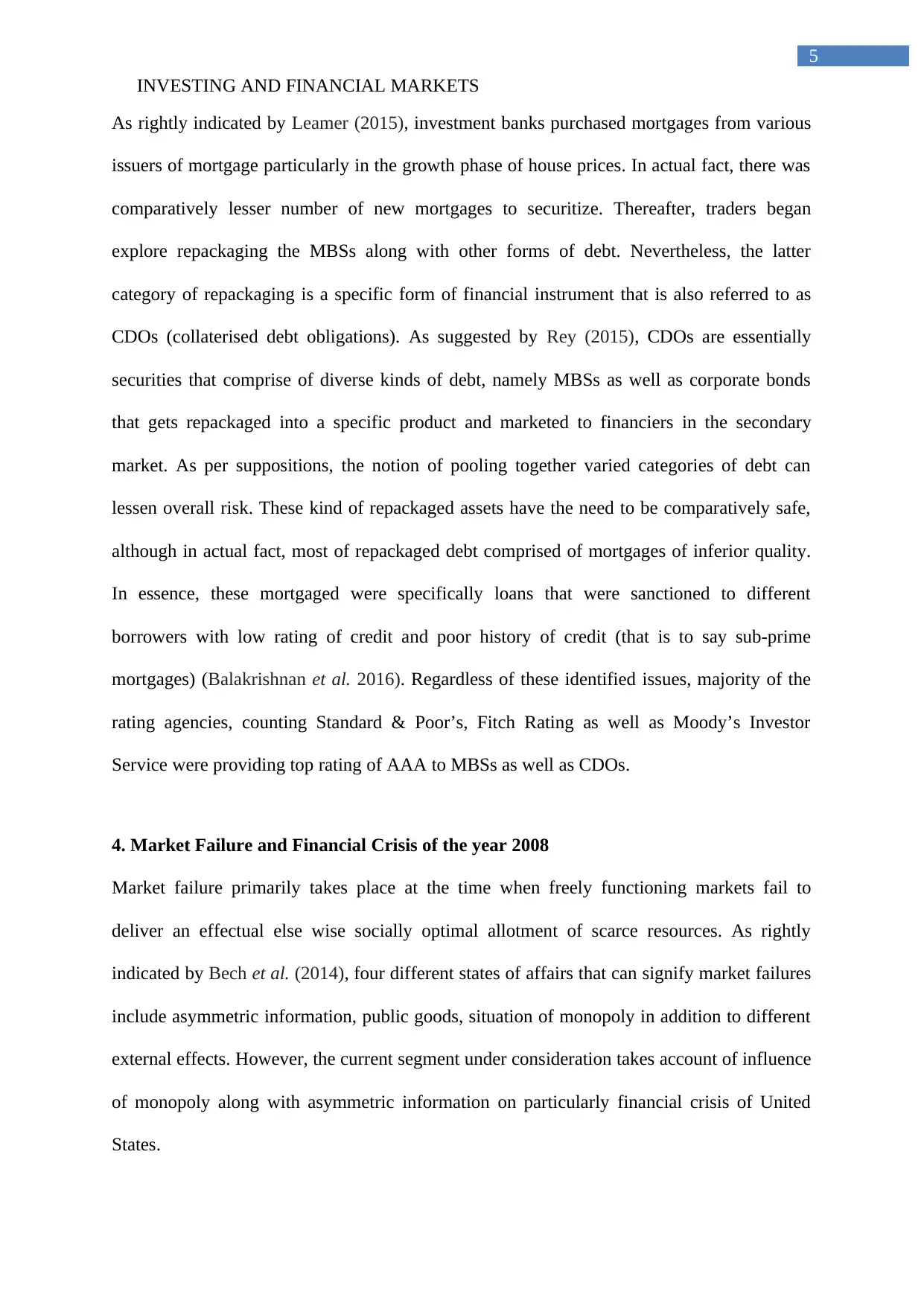
5
INVESTING AND FINANCIAL MARKETS
As rightly indicated by Leamer (2015), investment banks purchased mortgages from various
issuers of mortgage particularly in the growth phase of house prices. In actual fact, there was
comparatively lesser number of new mortgages to securitize. Thereafter, traders began
explore repackaging the MBSs along with other forms of debt. Nevertheless, the latter
category of repackaging is a specific form of financial instrument that is also referred to as
CDOs (collaterised debt obligations). As suggested by Rey (2015), CDOs are essentially
securities that comprise of diverse kinds of debt, namely MBSs as well as corporate bonds
that gets repackaged into a specific product and marketed to financiers in the secondary
market. As per suppositions, the notion of pooling together varied categories of debt can
lessen overall risk. These kind of repackaged assets have the need to be comparatively safe,
although in actual fact, most of repackaged debt comprised of mortgages of inferior quality.
In essence, these mortgaged were specifically loans that were sanctioned to different
borrowers with low rating of credit and poor history of credit (that is to say sub-prime
mortgages) (Balakrishnan et al. 2016). Regardless of these identified issues, majority of the
rating agencies, counting Standard & Poor’s, Fitch Rating as well as Moody’s Investor
Service were providing top rating of AAA to MBSs as well as CDOs.
4. Market Failure and Financial Crisis of the year 2008
Market failure primarily takes place at the time when freely functioning markets fail to
deliver an effectual else wise socially optimal allotment of scarce resources. As rightly
indicated by Bech et al. (2014), four different states of affairs that can signify market failures
include asymmetric information, public goods, situation of monopoly in addition to different
external effects. However, the current segment under consideration takes account of influence
of monopoly along with asymmetric information on particularly financial crisis of United
States.
INVESTING AND FINANCIAL MARKETS
As rightly indicated by Leamer (2015), investment banks purchased mortgages from various
issuers of mortgage particularly in the growth phase of house prices. In actual fact, there was
comparatively lesser number of new mortgages to securitize. Thereafter, traders began
explore repackaging the MBSs along with other forms of debt. Nevertheless, the latter
category of repackaging is a specific form of financial instrument that is also referred to as
CDOs (collaterised debt obligations). As suggested by Rey (2015), CDOs are essentially
securities that comprise of diverse kinds of debt, namely MBSs as well as corporate bonds
that gets repackaged into a specific product and marketed to financiers in the secondary
market. As per suppositions, the notion of pooling together varied categories of debt can
lessen overall risk. These kind of repackaged assets have the need to be comparatively safe,
although in actual fact, most of repackaged debt comprised of mortgages of inferior quality.
In essence, these mortgaged were specifically loans that were sanctioned to different
borrowers with low rating of credit and poor history of credit (that is to say sub-prime
mortgages) (Balakrishnan et al. 2016). Regardless of these identified issues, majority of the
rating agencies, counting Standard & Poor’s, Fitch Rating as well as Moody’s Investor
Service were providing top rating of AAA to MBSs as well as CDOs.
4. Market Failure and Financial Crisis of the year 2008
Market failure primarily takes place at the time when freely functioning markets fail to
deliver an effectual else wise socially optimal allotment of scarce resources. As rightly
indicated by Bech et al. (2014), four different states of affairs that can signify market failures
include asymmetric information, public goods, situation of monopoly in addition to different
external effects. However, the current segment under consideration takes account of influence
of monopoly along with asymmetric information on particularly financial crisis of United
States.
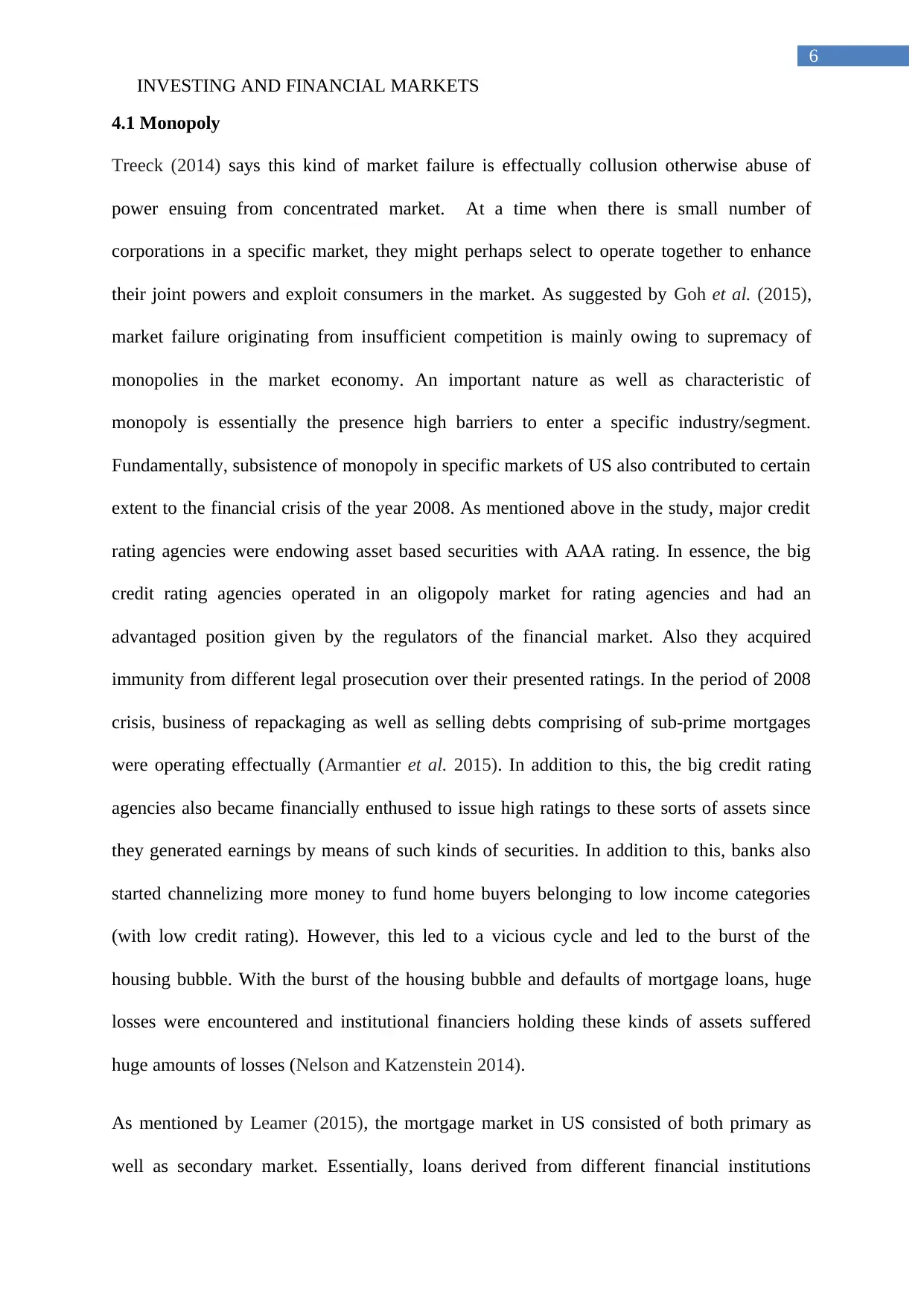
6
INVESTING AND FINANCIAL MARKETS
4.1 Monopoly
Treeck (2014) says this kind of market failure is effectually collusion otherwise abuse of
power ensuing from concentrated market. At a time when there is small number of
corporations in a specific market, they might perhaps select to operate together to enhance
their joint powers and exploit consumers in the market. As suggested by Goh et al. (2015),
market failure originating from insufficient competition is mainly owing to supremacy of
monopolies in the market economy. An important nature as well as characteristic of
monopoly is essentially the presence high barriers to enter a specific industry/segment.
Fundamentally, subsistence of monopoly in specific markets of US also contributed to certain
extent to the financial crisis of the year 2008. As mentioned above in the study, major credit
rating agencies were endowing asset based securities with AAA rating. In essence, the big
credit rating agencies operated in an oligopoly market for rating agencies and had an
advantaged position given by the regulators of the financial market. Also they acquired
immunity from different legal prosecution over their presented ratings. In the period of 2008
crisis, business of repackaging as well as selling debts comprising of sub-prime mortgages
were operating effectually (Armantier et al. 2015). In addition to this, the big credit rating
agencies also became financially enthused to issue high ratings to these sorts of assets since
they generated earnings by means of such kinds of securities. In addition to this, banks also
started channelizing more money to fund home buyers belonging to low income categories
(with low credit rating). However, this led to a vicious cycle and led to the burst of the
housing bubble. With the burst of the housing bubble and defaults of mortgage loans, huge
losses were encountered and institutional financiers holding these kinds of assets suffered
huge amounts of losses (Nelson and Katzenstein 2014).
As mentioned by Leamer (2015), the mortgage market in US consisted of both primary as
well as secondary market. Essentially, loans derived from different financial institutions
INVESTING AND FINANCIAL MARKETS
4.1 Monopoly
Treeck (2014) says this kind of market failure is effectually collusion otherwise abuse of
power ensuing from concentrated market. At a time when there is small number of
corporations in a specific market, they might perhaps select to operate together to enhance
their joint powers and exploit consumers in the market. As suggested by Goh et al. (2015),
market failure originating from insufficient competition is mainly owing to supremacy of
monopolies in the market economy. An important nature as well as characteristic of
monopoly is essentially the presence high barriers to enter a specific industry/segment.
Fundamentally, subsistence of monopoly in specific markets of US also contributed to certain
extent to the financial crisis of the year 2008. As mentioned above in the study, major credit
rating agencies were endowing asset based securities with AAA rating. In essence, the big
credit rating agencies operated in an oligopoly market for rating agencies and had an
advantaged position given by the regulators of the financial market. Also they acquired
immunity from different legal prosecution over their presented ratings. In the period of 2008
crisis, business of repackaging as well as selling debts comprising of sub-prime mortgages
were operating effectually (Armantier et al. 2015). In addition to this, the big credit rating
agencies also became financially enthused to issue high ratings to these sorts of assets since
they generated earnings by means of such kinds of securities. In addition to this, banks also
started channelizing more money to fund home buyers belonging to low income categories
(with low credit rating). However, this led to a vicious cycle and led to the burst of the
housing bubble. With the burst of the housing bubble and defaults of mortgage loans, huge
losses were encountered and institutional financiers holding these kinds of assets suffered
huge amounts of losses (Nelson and Katzenstein 2014).
As mentioned by Leamer (2015), the mortgage market in US consisted of both primary as
well as secondary market. Essentially, loans derived from different financial institutions
⊘ This is a preview!⊘
Do you want full access?
Subscribe today to unlock all pages.

Trusted by 1+ million students worldwide
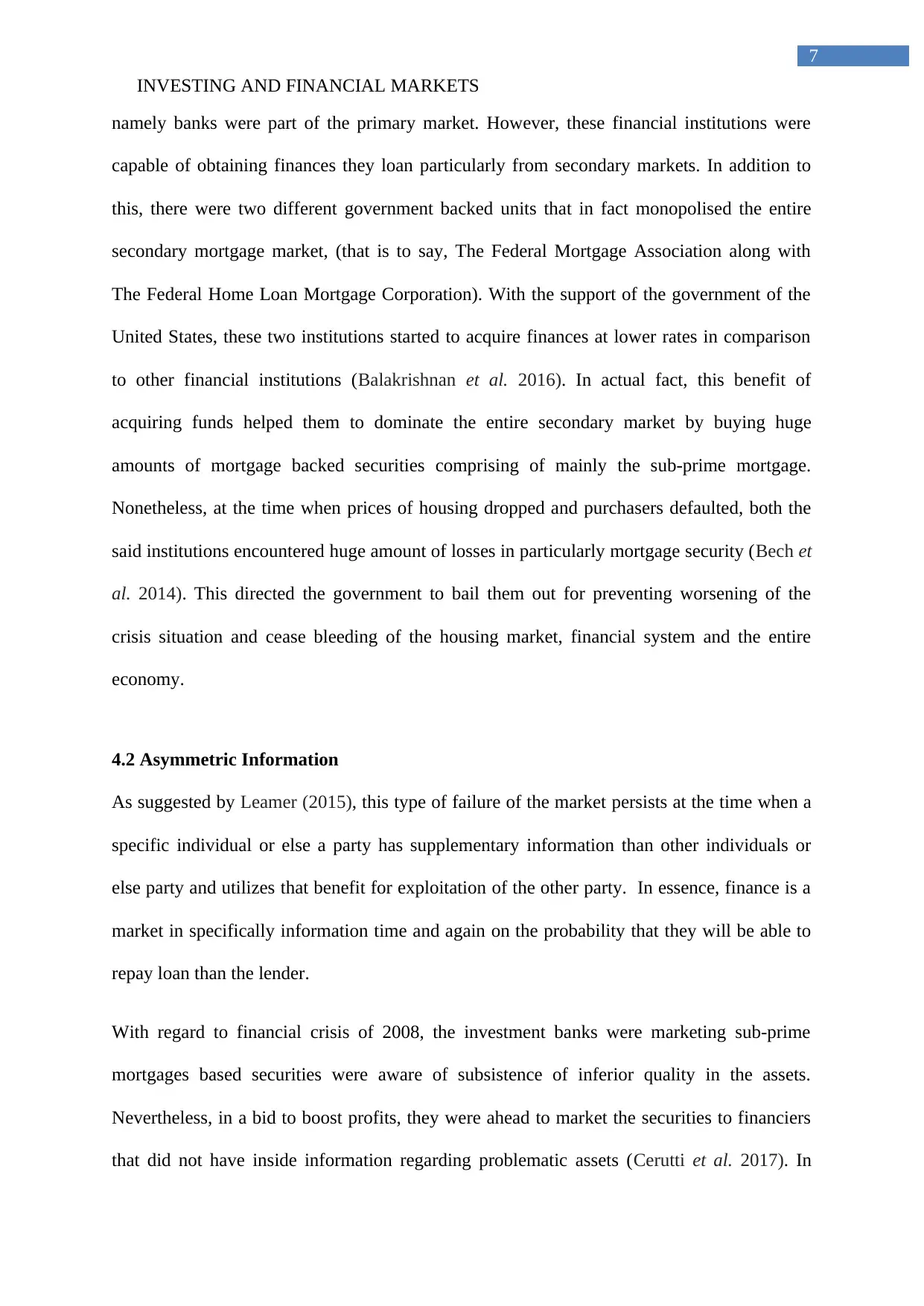
7
INVESTING AND FINANCIAL MARKETS
namely banks were part of the primary market. However, these financial institutions were
capable of obtaining finances they loan particularly from secondary markets. In addition to
this, there were two different government backed units that in fact monopolised the entire
secondary mortgage market, (that is to say, The Federal Mortgage Association along with
The Federal Home Loan Mortgage Corporation). With the support of the government of the
United States, these two institutions started to acquire finances at lower rates in comparison
to other financial institutions (Balakrishnan et al. 2016). In actual fact, this benefit of
acquiring funds helped them to dominate the entire secondary market by buying huge
amounts of mortgage backed securities comprising of mainly the sub-prime mortgage.
Nonetheless, at the time when prices of housing dropped and purchasers defaulted, both the
said institutions encountered huge amount of losses in particularly mortgage security (Bech et
al. 2014). This directed the government to bail them out for preventing worsening of the
crisis situation and cease bleeding of the housing market, financial system and the entire
economy.
4.2 Asymmetric Information
As suggested by Leamer (2015), this type of failure of the market persists at the time when a
specific individual or else a party has supplementary information than other individuals or
else party and utilizes that benefit for exploitation of the other party. In essence, finance is a
market in specifically information time and again on the probability that they will be able to
repay loan than the lender.
With regard to financial crisis of 2008, the investment banks were marketing sub-prime
mortgages based securities were aware of subsistence of inferior quality in the assets.
Nevertheless, in a bid to boost profits, they were ahead to market the securities to financiers
that did not have inside information regarding problematic assets (Cerutti et al. 2017). In
INVESTING AND FINANCIAL MARKETS
namely banks were part of the primary market. However, these financial institutions were
capable of obtaining finances they loan particularly from secondary markets. In addition to
this, there were two different government backed units that in fact monopolised the entire
secondary mortgage market, (that is to say, The Federal Mortgage Association along with
The Federal Home Loan Mortgage Corporation). With the support of the government of the
United States, these two institutions started to acquire finances at lower rates in comparison
to other financial institutions (Balakrishnan et al. 2016). In actual fact, this benefit of
acquiring funds helped them to dominate the entire secondary market by buying huge
amounts of mortgage backed securities comprising of mainly the sub-prime mortgage.
Nonetheless, at the time when prices of housing dropped and purchasers defaulted, both the
said institutions encountered huge amount of losses in particularly mortgage security (Bech et
al. 2014). This directed the government to bail them out for preventing worsening of the
crisis situation and cease bleeding of the housing market, financial system and the entire
economy.
4.2 Asymmetric Information
As suggested by Leamer (2015), this type of failure of the market persists at the time when a
specific individual or else a party has supplementary information than other individuals or
else party and utilizes that benefit for exploitation of the other party. In essence, finance is a
market in specifically information time and again on the probability that they will be able to
repay loan than the lender.
With regard to financial crisis of 2008, the investment banks were marketing sub-prime
mortgages based securities were aware of subsistence of inferior quality in the assets.
Nevertheless, in a bid to boost profits, they were ahead to market the securities to financiers
that did not have inside information regarding problematic assets (Cerutti et al. 2017). In
Paraphrase This Document
Need a fresh take? Get an instant paraphrase of this document with our AI Paraphraser
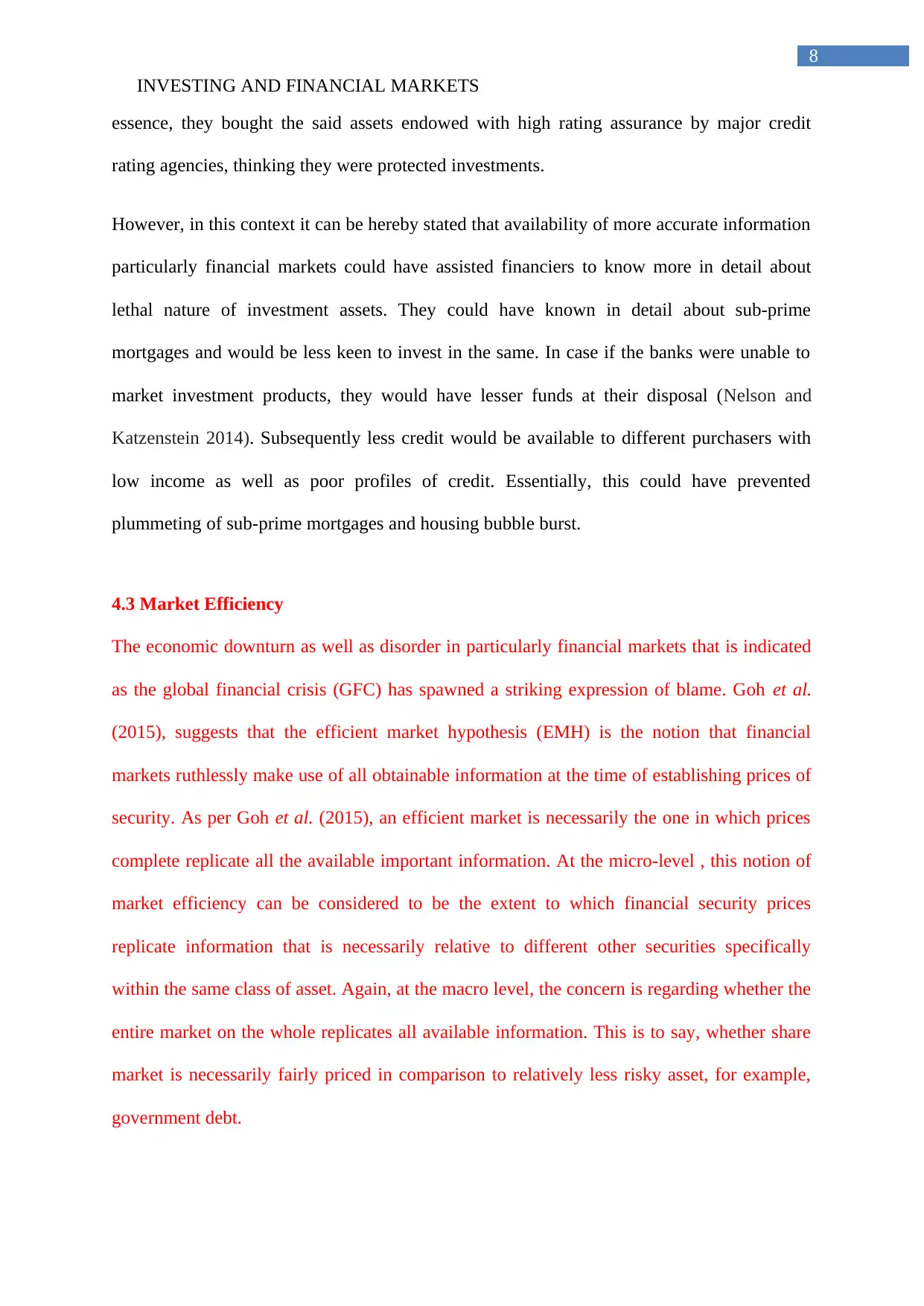
8
INVESTING AND FINANCIAL MARKETS
essence, they bought the said assets endowed with high rating assurance by major credit
rating agencies, thinking they were protected investments.
However, in this context it can be hereby stated that availability of more accurate information
particularly financial markets could have assisted financiers to know more in detail about
lethal nature of investment assets. They could have known in detail about sub-prime
mortgages and would be less keen to invest in the same. In case if the banks were unable to
market investment products, they would have lesser funds at their disposal (Nelson and
Katzenstein 2014). Subsequently less credit would be available to different purchasers with
low income as well as poor profiles of credit. Essentially, this could have prevented
plummeting of sub-prime mortgages and housing bubble burst.
4.3 Market Efficiency
The economic downturn as well as disorder in particularly financial markets that is indicated
as the global financial crisis (GFC) has spawned a striking expression of blame. Goh et al.
(2015), suggests that the efficient market hypothesis (EMH) is the notion that financial
markets ruthlessly make use of all obtainable information at the time of establishing prices of
security. As per Goh et al. (2015), an efficient market is necessarily the one in which prices
complete replicate all the available important information. At the micro-level , this notion of
market efficiency can be considered to be the extent to which financial security prices
replicate information that is necessarily relative to different other securities specifically
within the same class of asset. Again, at the macro level, the concern is regarding whether the
entire market on the whole replicates all available information. This is to say, whether share
market is necessarily fairly priced in comparison to relatively less risky asset, for example,
government debt.
INVESTING AND FINANCIAL MARKETS
essence, they bought the said assets endowed with high rating assurance by major credit
rating agencies, thinking they were protected investments.
However, in this context it can be hereby stated that availability of more accurate information
particularly financial markets could have assisted financiers to know more in detail about
lethal nature of investment assets. They could have known in detail about sub-prime
mortgages and would be less keen to invest in the same. In case if the banks were unable to
market investment products, they would have lesser funds at their disposal (Nelson and
Katzenstein 2014). Subsequently less credit would be available to different purchasers with
low income as well as poor profiles of credit. Essentially, this could have prevented
plummeting of sub-prime mortgages and housing bubble burst.
4.3 Market Efficiency
The economic downturn as well as disorder in particularly financial markets that is indicated
as the global financial crisis (GFC) has spawned a striking expression of blame. Goh et al.
(2015), suggests that the efficient market hypothesis (EMH) is the notion that financial
markets ruthlessly make use of all obtainable information at the time of establishing prices of
security. As per Goh et al. (2015), an efficient market is necessarily the one in which prices
complete replicate all the available important information. At the micro-level , this notion of
market efficiency can be considered to be the extent to which financial security prices
replicate information that is necessarily relative to different other securities specifically
within the same class of asset. Again, at the macro level, the concern is regarding whether the
entire market on the whole replicates all available information. This is to say, whether share
market is necessarily fairly priced in comparison to relatively less risky asset, for example,
government debt.
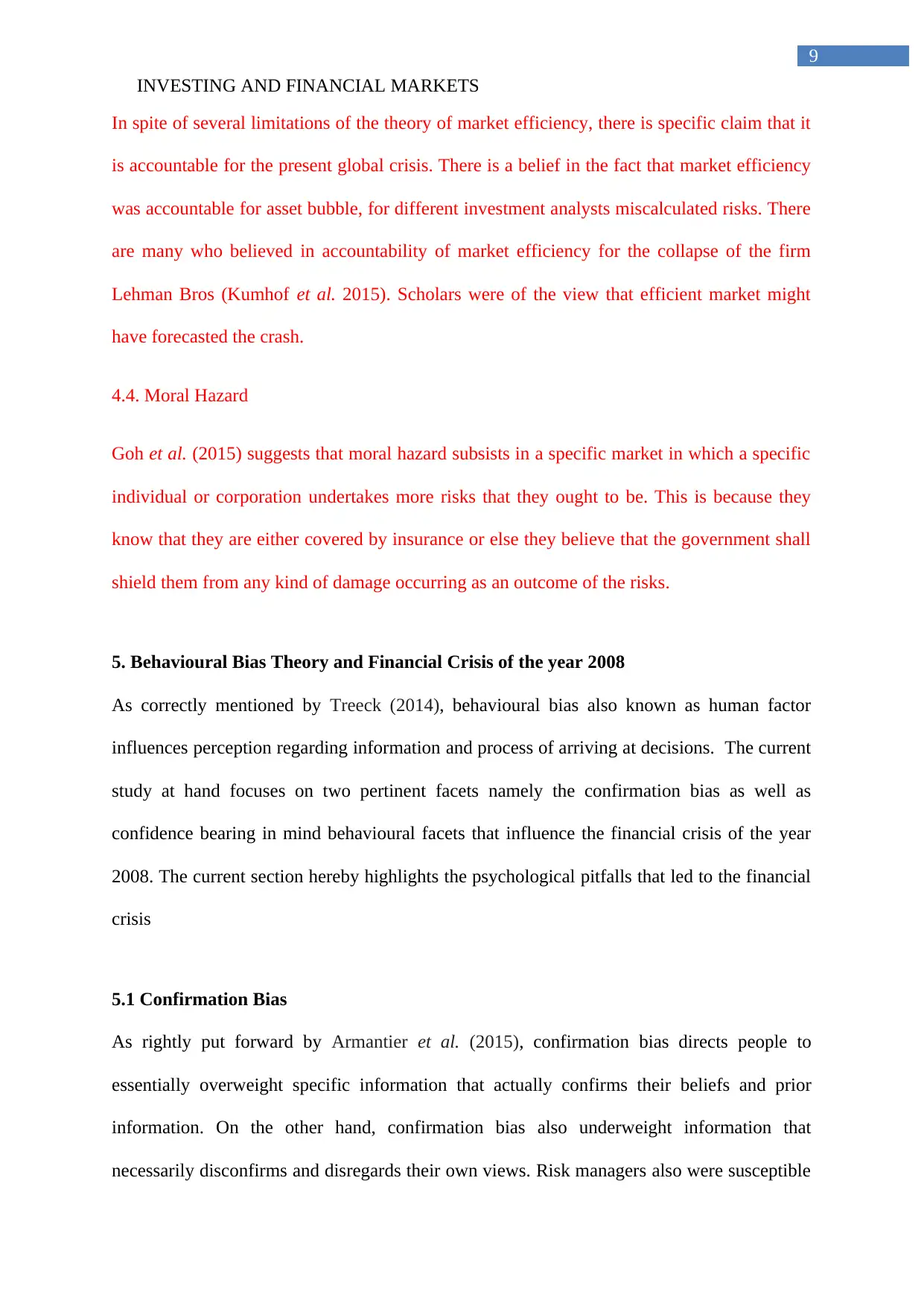
9
INVESTING AND FINANCIAL MARKETS
In spite of several limitations of the theory of market efficiency, there is specific claim that it
is accountable for the present global crisis. There is a belief in the fact that market efficiency
was accountable for asset bubble, for different investment analysts miscalculated risks. There
are many who believed in accountability of market efficiency for the collapse of the firm
Lehman Bros (Kumhof et al. 2015). Scholars were of the view that efficient market might
have forecasted the crash.
4.4. Moral Hazard
Goh et al. (2015) suggests that moral hazard subsists in a specific market in which a specific
individual or corporation undertakes more risks that they ought to be. This is because they
know that they are either covered by insurance or else they believe that the government shall
shield them from any kind of damage occurring as an outcome of the risks.
5. Behavioural Bias Theory and Financial Crisis of the year 2008
As correctly mentioned by Treeck (2014), behavioural bias also known as human factor
influences perception regarding information and process of arriving at decisions. The current
study at hand focuses on two pertinent facets namely the confirmation bias as well as
confidence bearing in mind behavioural facets that influence the financial crisis of the year
2008. The current section hereby highlights the psychological pitfalls that led to the financial
crisis
5.1 Confirmation Bias
As rightly put forward by Armantier et al. (2015), confirmation bias directs people to
essentially overweight specific information that actually confirms their beliefs and prior
information. On the other hand, confirmation bias also underweight information that
necessarily disconfirms and disregards their own views. Risk managers also were susceptible
INVESTING AND FINANCIAL MARKETS
In spite of several limitations of the theory of market efficiency, there is specific claim that it
is accountable for the present global crisis. There is a belief in the fact that market efficiency
was accountable for asset bubble, for different investment analysts miscalculated risks. There
are many who believed in accountability of market efficiency for the collapse of the firm
Lehman Bros (Kumhof et al. 2015). Scholars were of the view that efficient market might
have forecasted the crash.
4.4. Moral Hazard
Goh et al. (2015) suggests that moral hazard subsists in a specific market in which a specific
individual or corporation undertakes more risks that they ought to be. This is because they
know that they are either covered by insurance or else they believe that the government shall
shield them from any kind of damage occurring as an outcome of the risks.
5. Behavioural Bias Theory and Financial Crisis of the year 2008
As correctly mentioned by Treeck (2014), behavioural bias also known as human factor
influences perception regarding information and process of arriving at decisions. The current
study at hand focuses on two pertinent facets namely the confirmation bias as well as
confidence bearing in mind behavioural facets that influence the financial crisis of the year
2008. The current section hereby highlights the psychological pitfalls that led to the financial
crisis
5.1 Confirmation Bias
As rightly put forward by Armantier et al. (2015), confirmation bias directs people to
essentially overweight specific information that actually confirms their beliefs and prior
information. On the other hand, confirmation bias also underweight information that
necessarily disconfirms and disregards their own views. Risk managers also were susceptible
⊘ This is a preview!⊘
Do you want full access?
Subscribe today to unlock all pages.

Trusted by 1+ million students worldwide
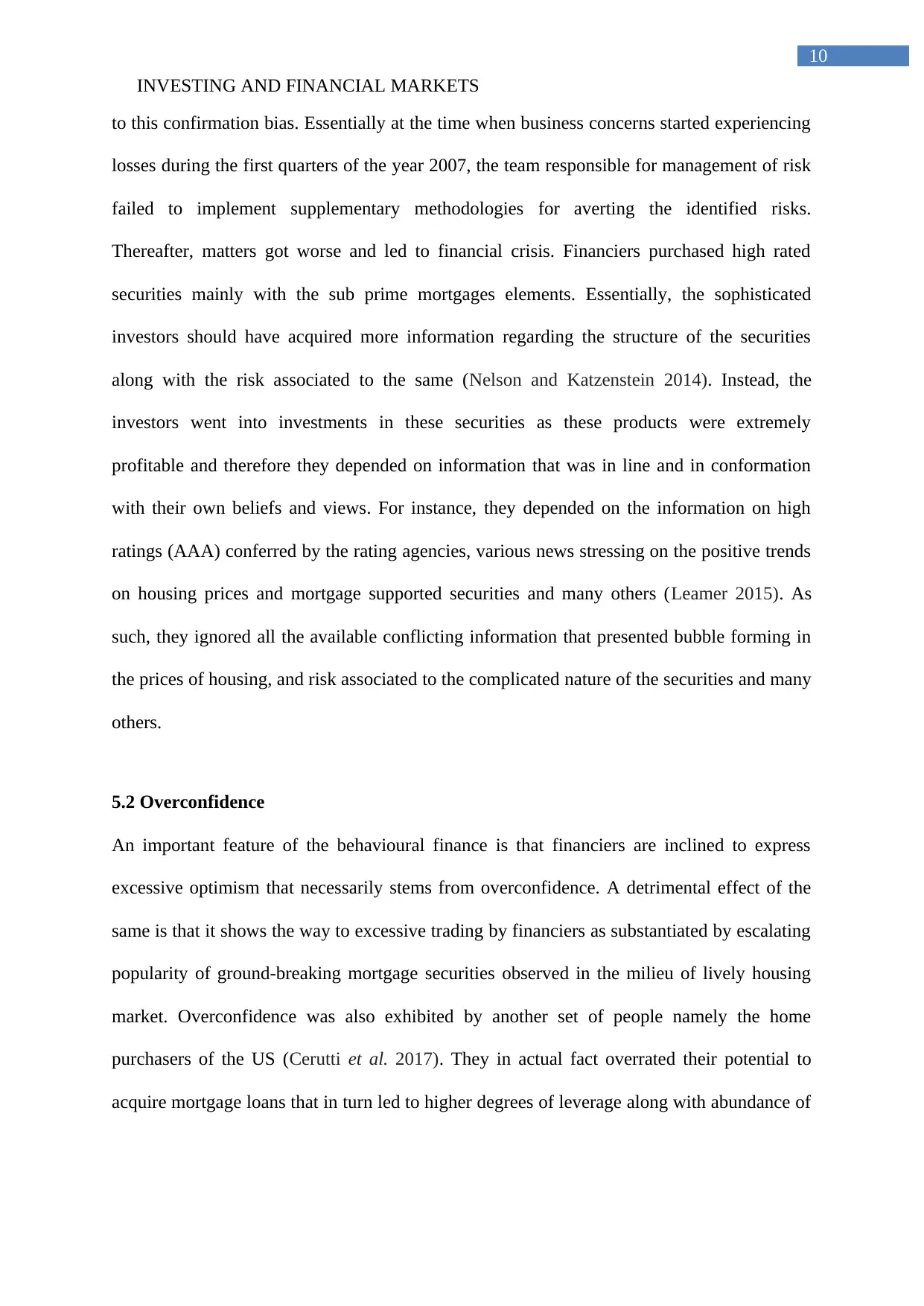
10
INVESTING AND FINANCIAL MARKETS
to this confirmation bias. Essentially at the time when business concerns started experiencing
losses during the first quarters of the year 2007, the team responsible for management of risk
failed to implement supplementary methodologies for averting the identified risks.
Thereafter, matters got worse and led to financial crisis. Financiers purchased high rated
securities mainly with the sub prime mortgages elements. Essentially, the sophisticated
investors should have acquired more information regarding the structure of the securities
along with the risk associated to the same (Nelson and Katzenstein 2014). Instead, the
investors went into investments in these securities as these products were extremely
profitable and therefore they depended on information that was in line and in conformation
with their own beliefs and views. For instance, they depended on the information on high
ratings (AAA) conferred by the rating agencies, various news stressing on the positive trends
on housing prices and mortgage supported securities and many others (Leamer 2015). As
such, they ignored all the available conflicting information that presented bubble forming in
the prices of housing, and risk associated to the complicated nature of the securities and many
others.
5.2 Overconfidence
An important feature of the behavioural finance is that financiers are inclined to express
excessive optimism that necessarily stems from overconfidence. A detrimental effect of the
same is that it shows the way to excessive trading by financiers as substantiated by escalating
popularity of ground-breaking mortgage securities observed in the milieu of lively housing
market. Overconfidence was also exhibited by another set of people namely the home
purchasers of the US (Cerutti et al. 2017). They in actual fact overrated their potential to
acquire mortgage loans that in turn led to higher degrees of leverage along with abundance of
INVESTING AND FINANCIAL MARKETS
to this confirmation bias. Essentially at the time when business concerns started experiencing
losses during the first quarters of the year 2007, the team responsible for management of risk
failed to implement supplementary methodologies for averting the identified risks.
Thereafter, matters got worse and led to financial crisis. Financiers purchased high rated
securities mainly with the sub prime mortgages elements. Essentially, the sophisticated
investors should have acquired more information regarding the structure of the securities
along with the risk associated to the same (Nelson and Katzenstein 2014). Instead, the
investors went into investments in these securities as these products were extremely
profitable and therefore they depended on information that was in line and in conformation
with their own beliefs and views. For instance, they depended on the information on high
ratings (AAA) conferred by the rating agencies, various news stressing on the positive trends
on housing prices and mortgage supported securities and many others (Leamer 2015). As
such, they ignored all the available conflicting information that presented bubble forming in
the prices of housing, and risk associated to the complicated nature of the securities and many
others.
5.2 Overconfidence
An important feature of the behavioural finance is that financiers are inclined to express
excessive optimism that necessarily stems from overconfidence. A detrimental effect of the
same is that it shows the way to excessive trading by financiers as substantiated by escalating
popularity of ground-breaking mortgage securities observed in the milieu of lively housing
market. Overconfidence was also exhibited by another set of people namely the home
purchasers of the US (Cerutti et al. 2017). They in actual fact overrated their potential to
acquire mortgage loans that in turn led to higher degrees of leverage along with abundance of
Paraphrase This Document
Need a fresh take? Get an instant paraphrase of this document with our AI Paraphraser
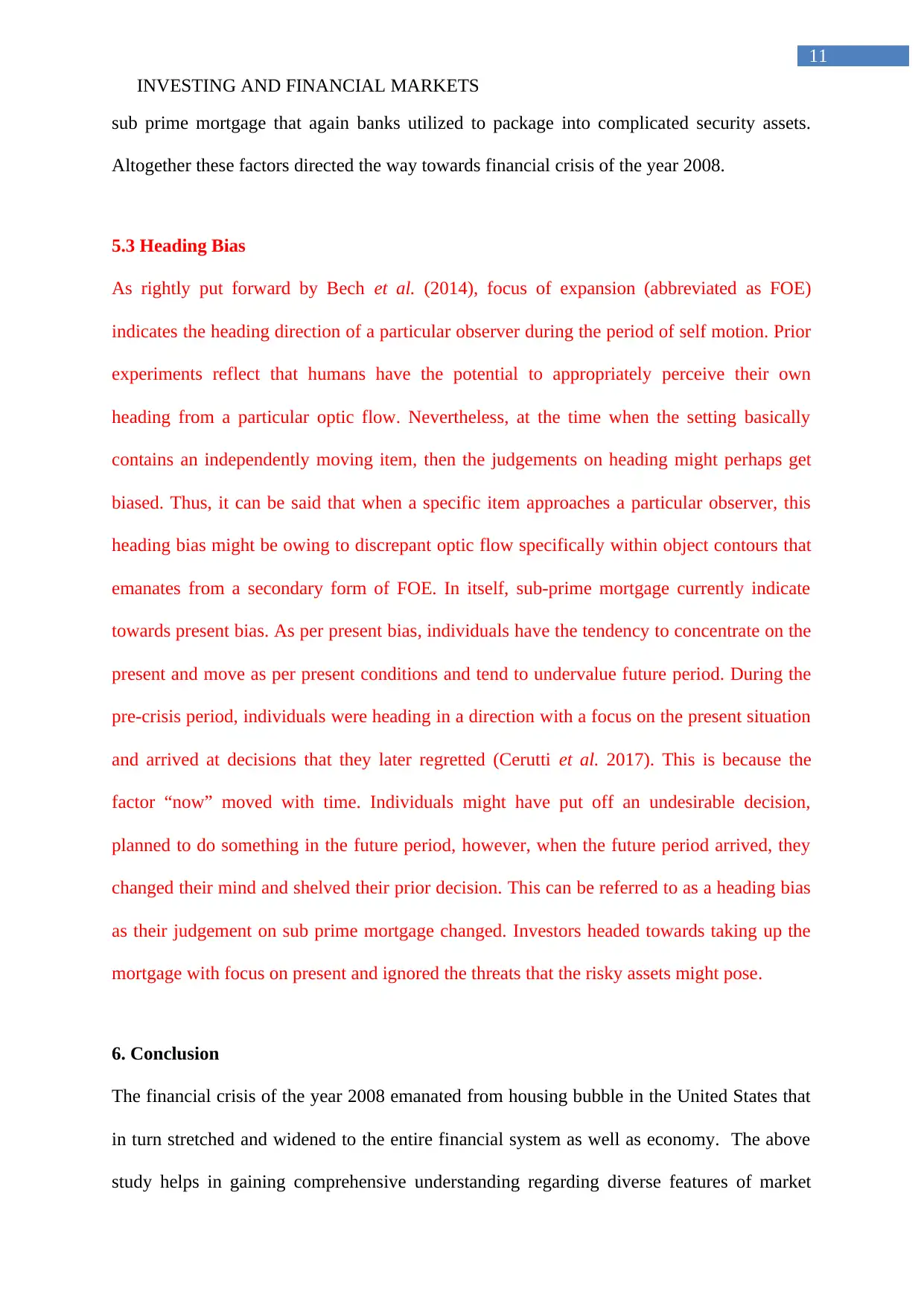
11
INVESTING AND FINANCIAL MARKETS
sub prime mortgage that again banks utilized to package into complicated security assets.
Altogether these factors directed the way towards financial crisis of the year 2008.
5.3 Heading Bias
As rightly put forward by Bech et al. (2014), focus of expansion (abbreviated as FOE)
indicates the heading direction of a particular observer during the period of self motion. Prior
experiments reflect that humans have the potential to appropriately perceive their own
heading from a particular optic flow. Nevertheless, at the time when the setting basically
contains an independently moving item, then the judgements on heading might perhaps get
biased. Thus, it can be said that when a specific item approaches a particular observer, this
heading bias might be owing to discrepant optic flow specifically within object contours that
emanates from a secondary form of FOE. In itself, sub-prime mortgage currently indicate
towards present bias. As per present bias, individuals have the tendency to concentrate on the
present and move as per present conditions and tend to undervalue future period. During the
pre-crisis period, individuals were heading in a direction with a focus on the present situation
and arrived at decisions that they later regretted (Cerutti et al. 2017). This is because the
factor “now” moved with time. Individuals might have put off an undesirable decision,
planned to do something in the future period, however, when the future period arrived, they
changed their mind and shelved their prior decision. This can be referred to as a heading bias
as their judgement on sub prime mortgage changed. Investors headed towards taking up the
mortgage with focus on present and ignored the threats that the risky assets might pose.
6. Conclusion
The financial crisis of the year 2008 emanated from housing bubble in the United States that
in turn stretched and widened to the entire financial system as well as economy. The above
study helps in gaining comprehensive understanding regarding diverse features of market
INVESTING AND FINANCIAL MARKETS
sub prime mortgage that again banks utilized to package into complicated security assets.
Altogether these factors directed the way towards financial crisis of the year 2008.
5.3 Heading Bias
As rightly put forward by Bech et al. (2014), focus of expansion (abbreviated as FOE)
indicates the heading direction of a particular observer during the period of self motion. Prior
experiments reflect that humans have the potential to appropriately perceive their own
heading from a particular optic flow. Nevertheless, at the time when the setting basically
contains an independently moving item, then the judgements on heading might perhaps get
biased. Thus, it can be said that when a specific item approaches a particular observer, this
heading bias might be owing to discrepant optic flow specifically within object contours that
emanates from a secondary form of FOE. In itself, sub-prime mortgage currently indicate
towards present bias. As per present bias, individuals have the tendency to concentrate on the
present and move as per present conditions and tend to undervalue future period. During the
pre-crisis period, individuals were heading in a direction with a focus on the present situation
and arrived at decisions that they later regretted (Cerutti et al. 2017). This is because the
factor “now” moved with time. Individuals might have put off an undesirable decision,
planned to do something in the future period, however, when the future period arrived, they
changed their mind and shelved their prior decision. This can be referred to as a heading bias
as their judgement on sub prime mortgage changed. Investors headed towards taking up the
mortgage with focus on present and ignored the threats that the risky assets might pose.
6. Conclusion
The financial crisis of the year 2008 emanated from housing bubble in the United States that
in turn stretched and widened to the entire financial system as well as economy. The above
study helps in gaining comprehensive understanding regarding diverse features of market
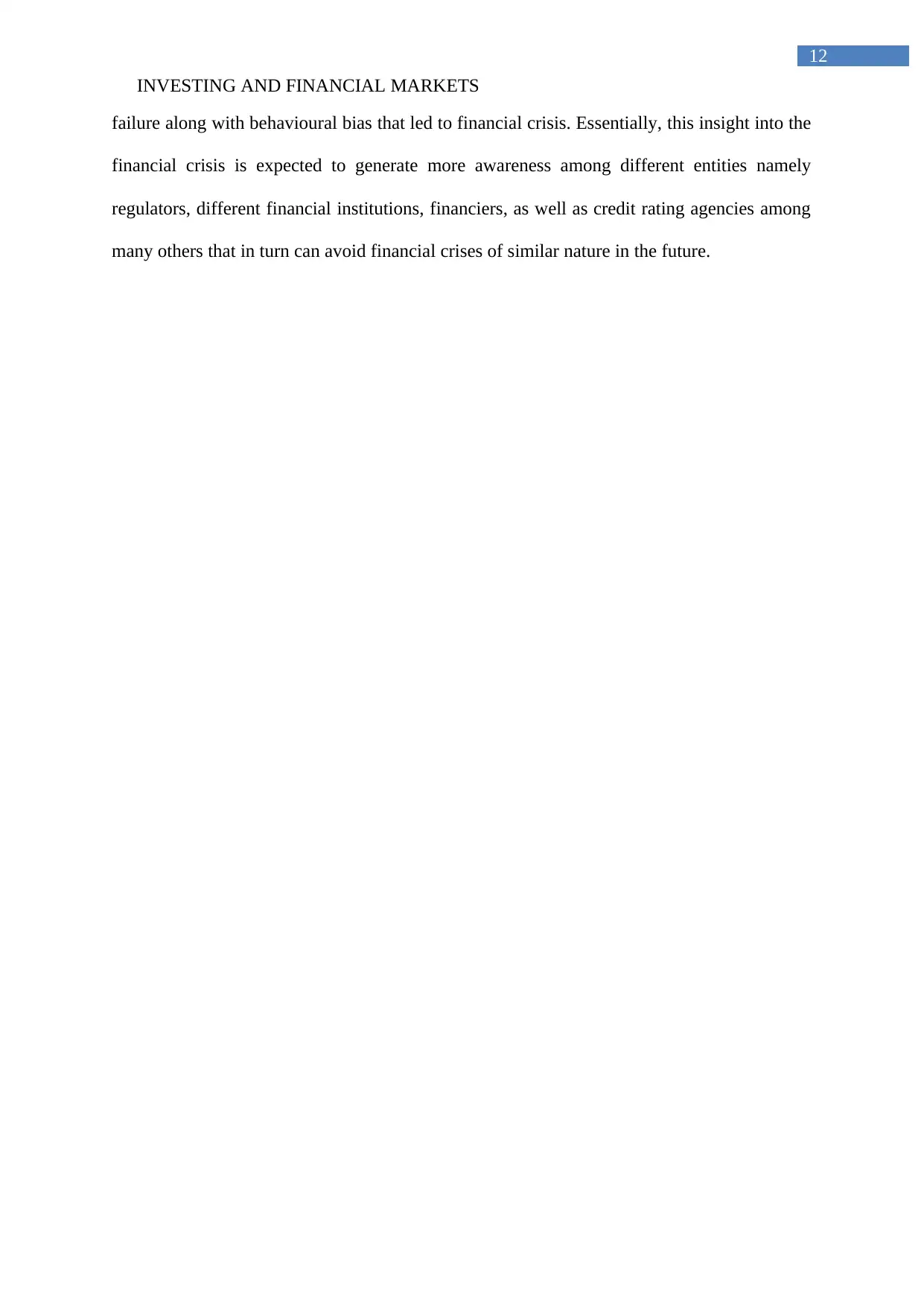
12
INVESTING AND FINANCIAL MARKETS
failure along with behavioural bias that led to financial crisis. Essentially, this insight into the
financial crisis is expected to generate more awareness among different entities namely
regulators, different financial institutions, financiers, as well as credit rating agencies among
many others that in turn can avoid financial crises of similar nature in the future.
INVESTING AND FINANCIAL MARKETS
failure along with behavioural bias that led to financial crisis. Essentially, this insight into the
financial crisis is expected to generate more awareness among different entities namely
regulators, different financial institutions, financiers, as well as credit rating agencies among
many others that in turn can avoid financial crises of similar nature in the future.
⊘ This is a preview!⊘
Do you want full access?
Subscribe today to unlock all pages.

Trusted by 1+ million students worldwide
1 out of 14
Related Documents
Your All-in-One AI-Powered Toolkit for Academic Success.
+13062052269
info@desklib.com
Available 24*7 on WhatsApp / Email
![[object Object]](/_next/static/media/star-bottom.7253800d.svg)
Unlock your academic potential
Copyright © 2020–2025 A2Z Services. All Rights Reserved. Developed and managed by ZUCOL.





